FTA (изд-во). Flexography: Principles And Practices. Vol.1-6
Подождите немного. Документ загружается.

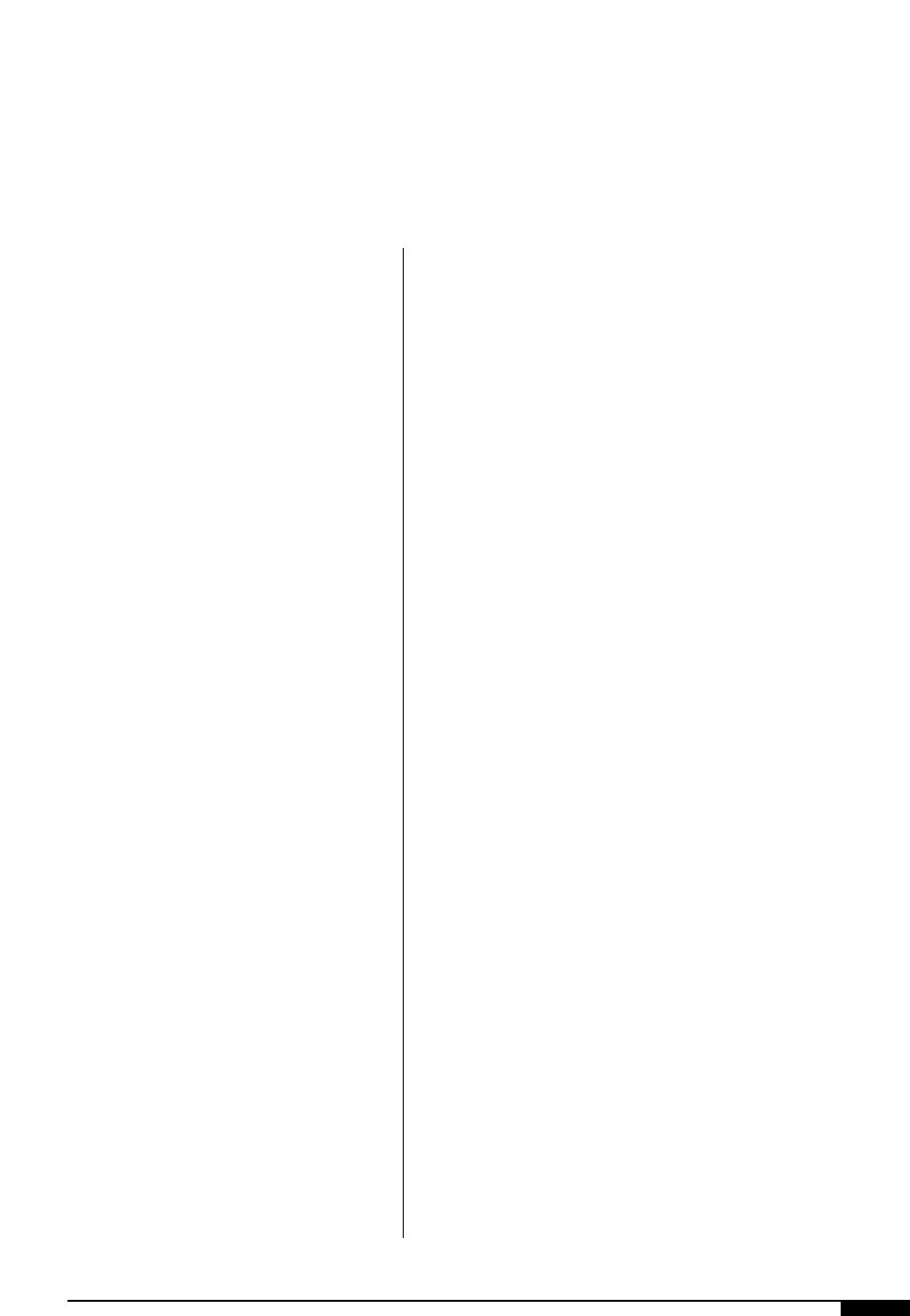
PRESSES AND PRESS EQUIPMENT 13
Narrow-Web Presses
N
arrow-web flexo has most
recently been defined as any
web width less than 20" (508
mm). While this is an arbitrary
designation, it will serve as a
definition for this chapter. The
vast majority of narrow-web presses, how-
ever, are 16" (406 mm) or less, and most are
10" (254 mm) or smaller. However, changing
market conditions and the need for greater
productivity have created a definite trend
toward the use of wider presses. Web widths
of 10" (254 mm) and 13" (330 mm) have sup-
planted the old standards of 6" (152 mm) to
8" (203 mm) web widths. Presses with 18"
(457 mm) to 20" (508 mm) web widths are
becoming more common.
Narrow-web flexography is also character-
ized as a rotary process with multiple in-line
converting functions. Variable print, or
repeat length, capability is a critical feature
in the markets served by narrow-web equip-
ment. With alternate printing processes, vary-
ing repeat is often accomplished with an
intermittent web motion. The elegant sim-
plicity of the flexo ink system, low-cost plate
cylinders, and the ease and cost effectiveness
of processing plates in a variety of sizes,
make an intermittent or platen type of sys-
tem unnecessary on narrow-web flexo press-
es. Plate cylinders are easily and economi-
cally changed on narrow-web presses, pro-
viding the ability to alter the repeat length
while maintaining rotary printing. Typical
narrow-web flexo presses have a print repeat
range from approximately 4" (101 mm) to 24"
(609 mm) in 0.125" (3 mm) increments.
It is rare for a narrow-web flexo press to
be limited to simply printing. Typical appli-
cations will include some form of in-line
converting operation, such as die-cutting,
slitting or laminating. The ability of narrow
web presses to do multiple operations in-line
at high speeds provides tremendous produc-
tion efficiencies and cost savings to users.
The converting operations performed on
narrow-web presses are also usually accom-
plished by rotary means. However, platen, or
flatbed, die-cutting can be used, and foil for
stamping can also be fed intermittently.
DEVELOPMENT AND GROWTH
The origin of narrow-web flexography is
usually placed in the period immediately
after WW II. At that time, Mark Andrews Sr.
(1904-1980), the founder of Mark Andy, Inc.,
made his first presses for printing on the
then new product, “Scotch Tape.” Others
may have made similar equipment prior to
this but, unquestionably, Andrews was the
first to begin the sustained manufacture and
marketing of narrow-web flexo presses.
Flexo then was still called the “aniline”
process, named for the aniline dies in the
inks. These initial presses were designed to
sit on a workbench or table and were used
for making labels from self-wound, self-
adhesive tapes. Web widths were 2" to 4" (50
mm to 100 mm).
Andrews is also credited with another
innovation that has shaped the narrow web
flexo industry: the development of rotary die-
cutting and its integration into narrow-web
presses. Initially, these rotary dies were used
for perforating tapes. As pressure-sensitive
roll label markets emerged, the entrepre-
neurs building that industry recognized the
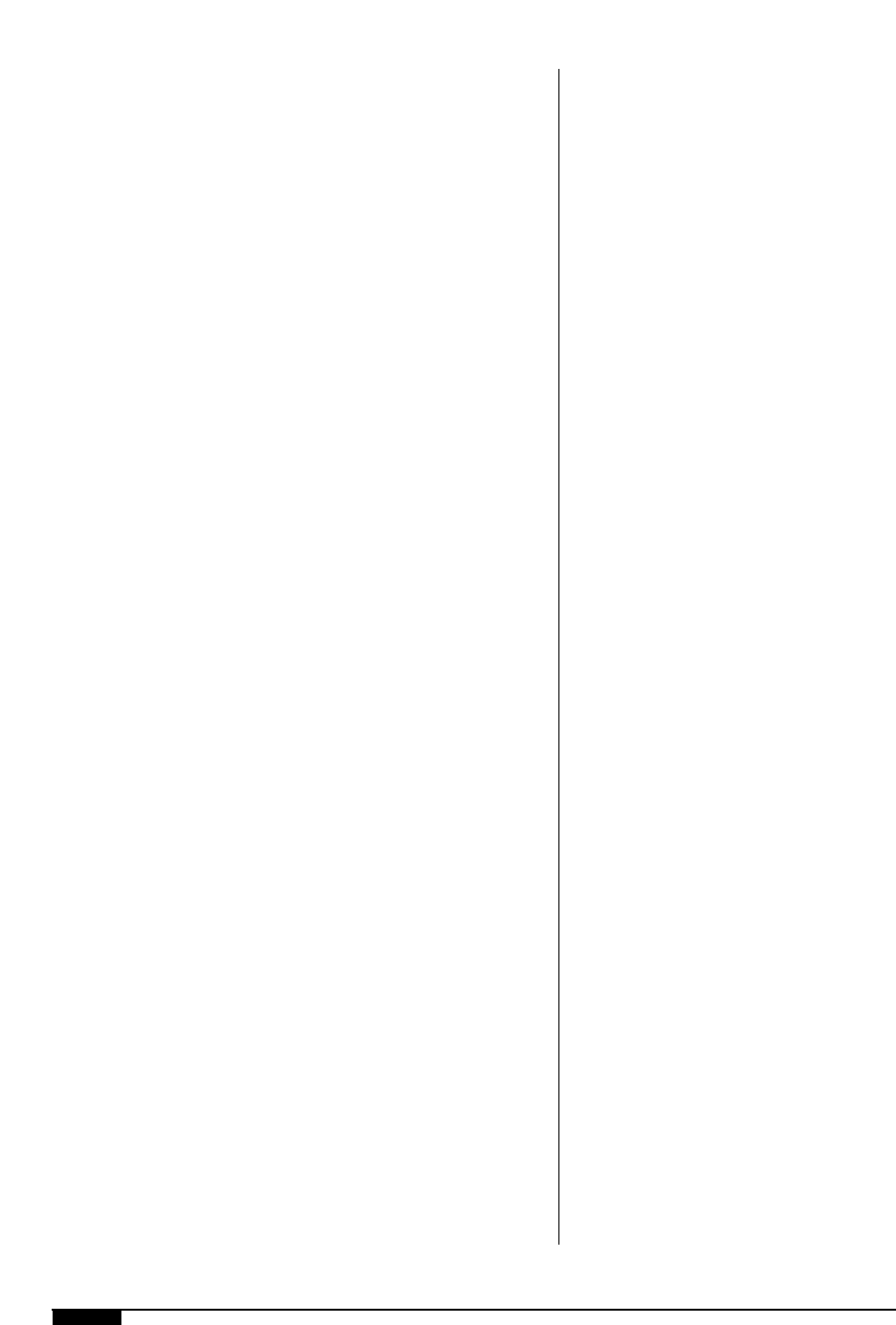
14 FLEXOGRAPHY: PRINCIPLES & PRACTICES
advantage and cost effectiveness of in-line
printing and die-cutting on narrow-web flexo
equipment. These early innovators forged a
bond between pressure-sensitive roll labels,
flexographic printing and in-line rotary die-
cutting that has facilitated and forced growth
and advancement within each of the tech-
nologies and built them into world class dis-
ciplines.
The explosive growth of pressure-sensitive
labels (estimated to have a value of $10 bil-
lion in North America by the year 2000) has
fueled the growth and development of nar-
row-web flexography. However, narrow-web
presses are used for a vast variety of prod-
ucts in addition to pressure sensitive labels.
Many of these products are other forms of
product identification or promotion such as
tags, in-mold labels, sleeves and cartons.
Lottery pieces and tickets for everything
from sporting events to transportation and
turnpike usage are common narrow web
applications. Medical and pharmaceutical
packaging is produced on narrow-web press-
es, as are foil and paper lids. Increasingly,
narrow-web presses are used for manufac-
turing folding cartons and flexible packaging.
Advantages
Narrow-web flexography has many ad-
vantages that make its economics very com-
pelling in a world of higher quality, cost-
effective productivity, and shorter, more fre-
quent runs. In-line processing reduces the
time and costs associated with multiple pro-
cessing steps, such as those that occur with
the sheet-fed offset manufacturing of folding
cartons. This advantage is reinforced with
the multitude of tasks that can be combined
on narrow-web presses. These tasks range
from corona treatment to multiple forms of
graphic imaging, including variable data,
overprint varnishes and laminates. In-line
die-cutting, hole punching, perforating,
creasing, embossing and folding can also be
done on narrow-web flexo presses. Multiple
webs can be processed, married together
and delivered in roll, sheet or stacked for-
mats. The multiplex character of narrow-
web presses gives their users a strong cost
advantage on a wide variety of products.
In addition to the time and labor saved by
performing multiple operations on a narrow-
web flexo press, material waste is also
reduced. The spoilage associated with han-
dling and moving of the work in process is
eliminated, as is the scrap generated by mul-
tiple setups in the manufacturing pro-
cess. Since the material is typically the
largest cost element in the finished product,
waste reduction can have a tremendous
impact on profitability.
Another advantage of narrow-web flexo
presses is their ability to be set up and
changed-over quickly. Part of this efficiency
is due to the nature of flexo printing com-
pared to other technologies, and part is
inherent from being smaller than their wide-
web counterparts. Narrow-web press manu-
facturers have also made setup and change-
over efficiency a key element of their
designs. This concerted effort by press
designers has dramatically reduced the time
required to set up narrow web presses, even
as the complexity and difficulty of the
work performed on them has increased.
Sophisticated change out and clean up pro-
cedures are increasingly utilized by convert-
ers to achieve maximum productivity of
their equipment. These innovations have led
to makeready times of 10 minutes or less for
changing from one six color job to another,
on state-of-the-art narrow web presses. This
quick changeover includes plate rolls, ink
fountains, anilox rolls, metering system,
material and die changes.
The final element that gives narrow-web
flexo a significant advantage over competing
technologies is the quality being produced by
narrow-web converters. Advances in pre-
press, plate, anilox, ink and press technolo-
gies have been eagerly embraced by narrow-

web converters and combined into a world
class printing technology. While each printing
process has its own unique set of strengths
and weaknesses, flexo has made tremendous
progress in overcoming its weaknesses and
further advancing its strengths. As a conse-
quence, process work of 200 and 225 lpi is
now being printed on narrow-web flexo
presses, while solids are richer and smoother
than ever before.
TYPES OF NARROW-WEB PRESSES
There are four basic design styles of nar-
row-web presses: central impression, in-line,
stack and platform. These presses are distin-
guished from one another in the first
instance by their web paths, as determined
PRESSES AND PRESS EQUIPMENT 15
f A typical narrow-web
four-color CI press.
Among the features
that make it popular is
its relatively low cost,
small footprint, and
easy-to-use controls
and accessories.
by the spatial orientation of their printing sta-
tions. From this difference, a number of
other characteristics are derived.
Central Impression Presses
The earliest narrow-web flexo label presses
were central impression, and this design has
remained popular through the years. Narrow-
web central impression presses, like their
wide-web counterparts, are characterized by
the location of all the printing units around a
common impression drum (Figure
f
).
Unlike wide-web central impression presses,
the typical narrow-web CI press is three or
four colors. Satellite stations, not located on
the central drum, can be added to obtain five-
or six-color capability.
Narrow-web central impression presses
A
B
D
C
J
E
K
L
G
F
H
I
A Laminate
B Laminate Waste Rewind
C Die Cutting
D Main Dryer
E Die Cutting
F Waste Rewind
G Rewind 2
H Rewind 1
I Unwind
J Common Impression Cylinder
K Dryer Between Station
L Print Unit Casette
f
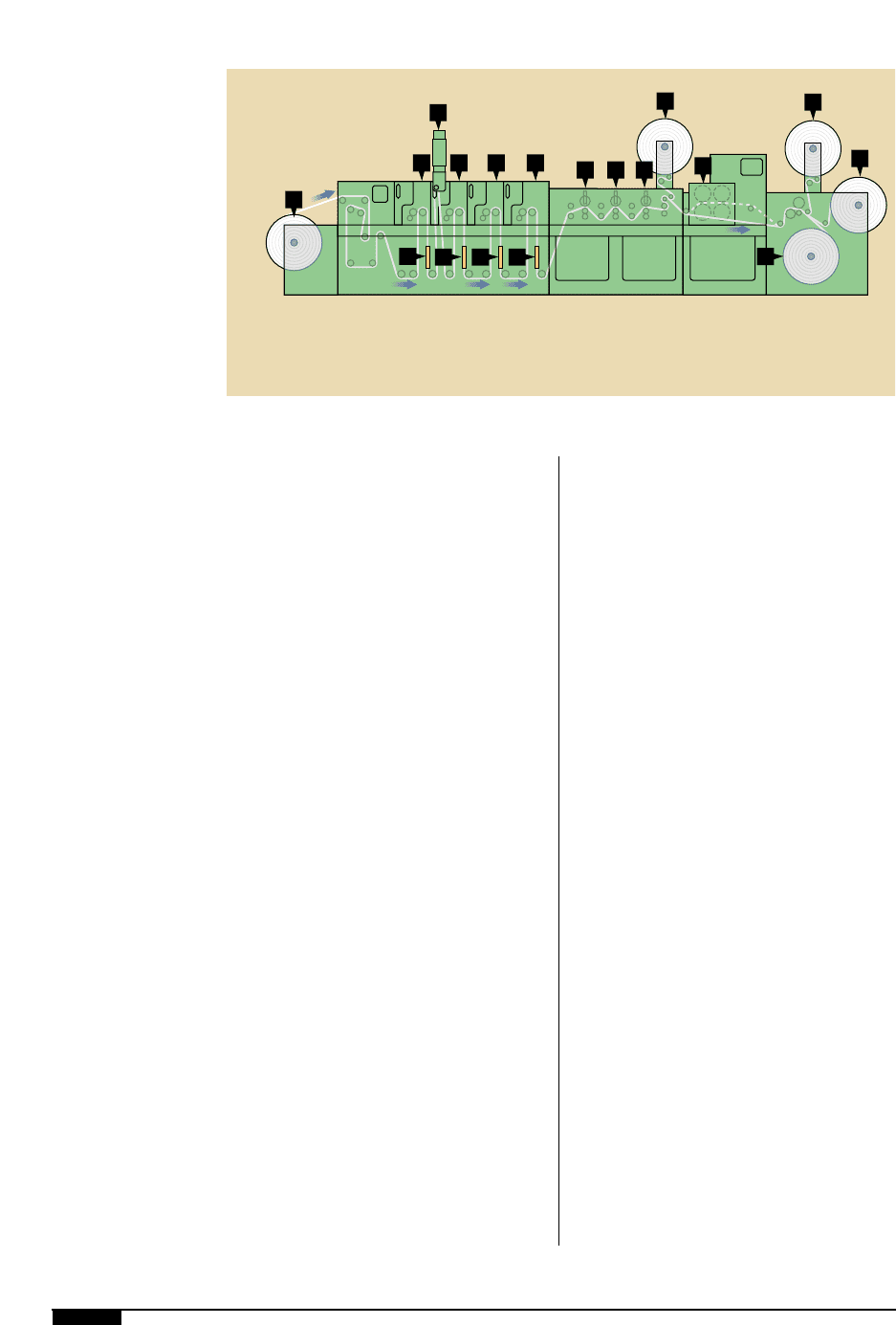
16 FLEXOGRAPHY: PRINCIPLES & PRACTICES
are relatively inexpensive and take up a
small amount of floor space. They typically
do not have sophisticated controls and
accessories, making them easy to operate
and maintain. These characteristics make
the design popular with smaller and start-up
companies, as well as with larger converters
needing additional capacity for low-end
work. This style of press is also often used
for training in educational institutions.
Because the web is captured on a com-
mon cylinder and not subject to tension
fluctuations as it is transported from station
to station, central impression presses hold
excellent color to color register. They are
well suited for printing difficult to control
materials, such as tapes, highly extensible
films and cloth.
The typical narrow-web central impression
press has a web width range of 6" (152 mm)
to 20" (508 mm). This narrow width, and the
limited number of colors on typical narrow-
web CI presses, have restricted their use in
the flexible packaging market. However, in
response to changes in the flexible packaging
market and its need for equipment better
suited for shorter run lengths, traditional
wide-web press manufacturers have intro-
duced narrower versions of their wide-web
central impression presses. These presses
are typically six to eight colors and have a
web width of 16" (406 mm) to 24" (609 mm).
While falling within the range defined as nar-
row web, the design of these presses is heav-
ily influenced by their wide-web origins, and
the reader is directed to the wide web chap-
ter for more information on them.
In-line Presses
In-line presses, as their name implies, have
their printing stations oriented horizontally
to one another (Figure
g
). Each printing
station has its own impression cylinder.
These presses are appreciably longer than
central impression presses, but are also
more versatile and provide the operator with
greater accessibility to the printing stations.
More than 75% of the narrow-web presses
sold today are in-line designs.
In-line presses are manufactured in a full
range of web widths, from 7" (178 mm) to 24"
(609 mm). They are often modular, i.e.,
designed to allow the buyer to specify the
number of print stations required, and, if nec-
essary, to add stations at a later date. The
number of print stations on an average in-line
press has increased over the years. Six to
eight colors are now typical, but 12 or more is
not uncommon. Even on the largest in-line
presses, register tolerance is typically less
than ±0.005" (0.13 mm) over a specified num-
ber of repeats.
g
In a typical narrow-
web in-line press,
printing stations are
configured horizontally,
providing versatility
and accessiblity to the
printing stations.
A
B
D D D
F
E
G
G
E
A Unwind
B Web Inverter
C Print Units
D Die Cutting
E Waste Removal
F Lamination
G Rewind
H Between Station Dryers
CCCC
H
H H H
g
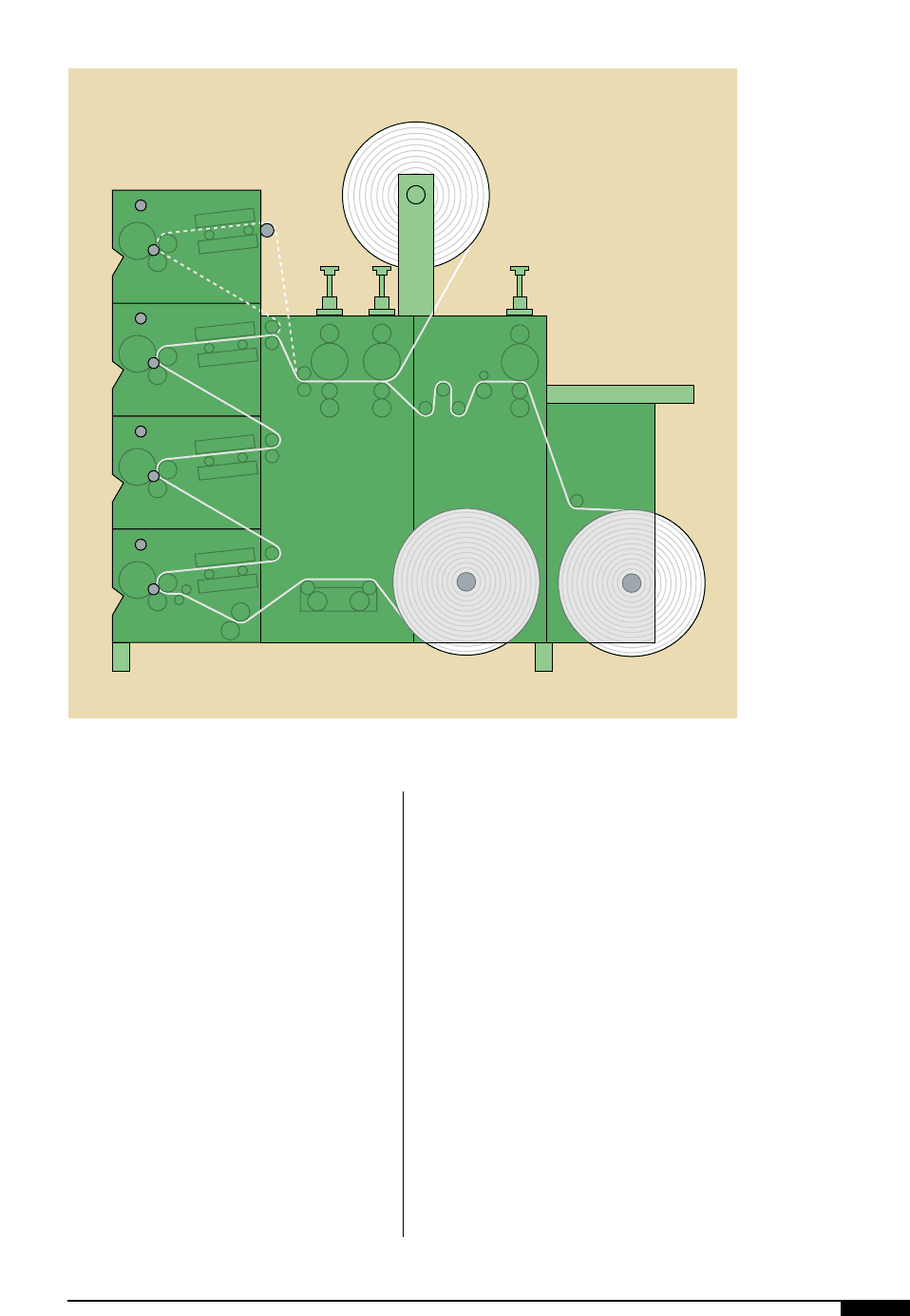
The range of available web widths, and the
number of print and converting positions
possible with in-line style presses, make
them very adaptable to a wide variety of
uses and markets. Their open, accessible
design allows many accessories to be added
to them for specialized requirements. Thus,
most of the narrow-web flexo presses used
for folding cartons, flexible packaging, lot-
tery tickets and coupon applications, are of
the in-line design.
There are many design variations within
the category of in-line presses. Some are
cantilevered, i.e., without a framework on
the operator’s side of the press, while others
are fully framed. All in-line presses have to
transport the web from one station, or mod-
ule, to another. However, the web path to
accomplish this may vary dramatically,
depending on the location of the interstation
dryers. Likewise, the level and sophistica-
tion of the press controls range from basic
manual, mechanical functions to nearly fully
automated presses.
Stack Presses
Narrow-web stack presses are character-
ized by the vertical relationship of their print
stations, and they are sometimes referred to
as “vertical in-line” presses (Figure
h
).
Stack presses can also have the print sta-
tions oriented in an inverted “U.” Like the
central impression press, the stack press
takes up a small amount of floor space. Like
the in-line press, the stack press has individ-
ual impression rollers. Stack presses are
PRESSES AND PRESS EQUIPMENT 17
h
A typical four-color
narrow-web stack
press, also known as a
vertical in-line press,
can be configured with
as many as eight print
stations.
Air Unwind
Print Station
Print Station
Print Station
4th Print Station or
Coating Station
Single
Rewind
Waste Windup
Sheeter
Double
Die
H
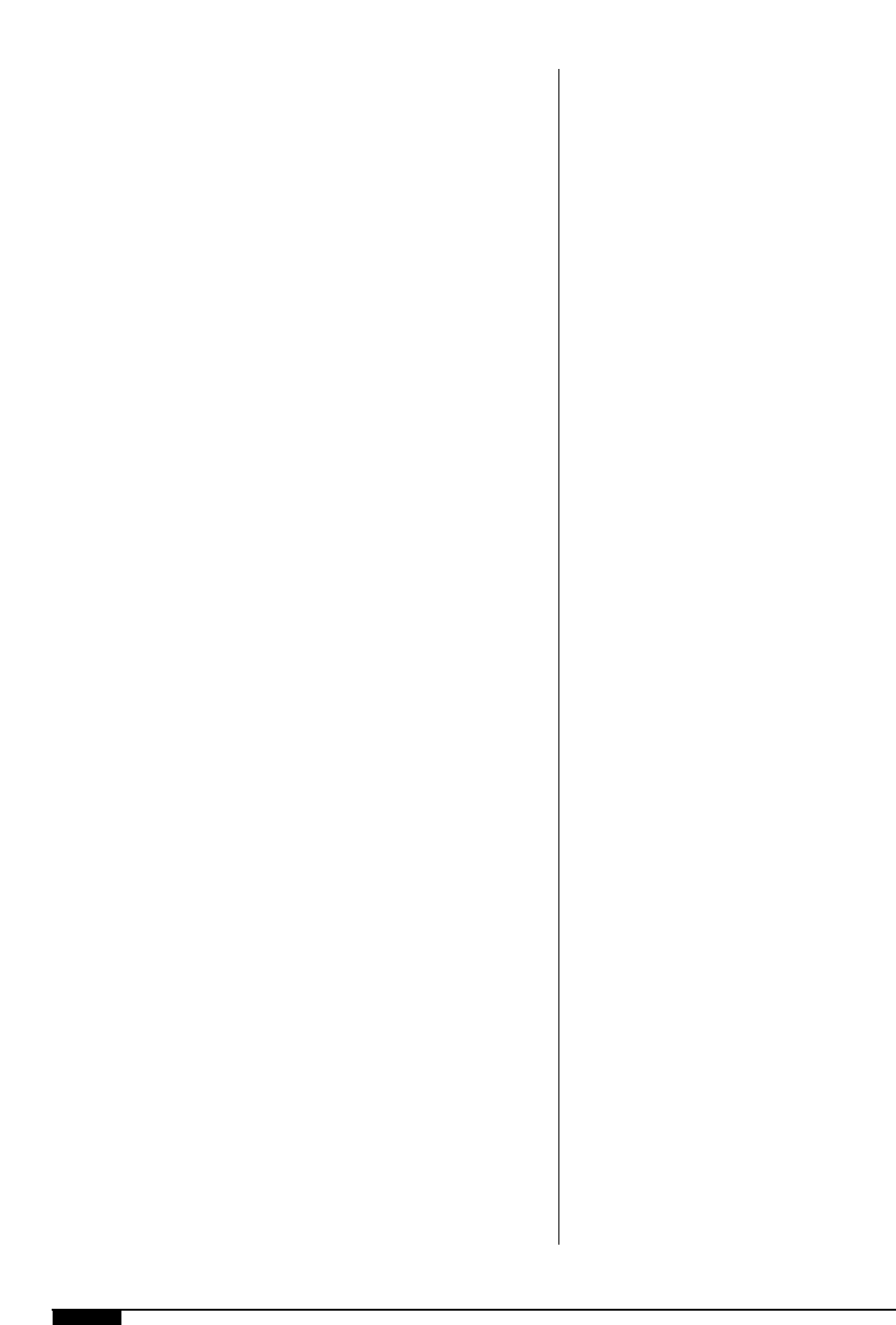
18 FLEXOGRAPHY: PRINCIPLES & PRACTICES
usually manufactured with four, six or eight
print stations.
In the narrow web industry, due to the
need for larger registration tolerances on
stack presses, they have not been as popular
as in-line and central impression presses.
However, stack presses do provide a good
solution to the converter with restricted
space and requiring more flexibility than can
be obtained with a central impression press.
Also, there is more distance for drying
between print stations on narrow-web stack
presses than on CI presses. This additional
drying time allows some job layouts to run at
a higher speed on a stack press than on a
central impression press.
Platform Presses
Platform presses are a recent develop-
ment in narrow-web flexo. Unlike CI, in-line
and stack presses, a platform press is not
distinguished from other presses by its web
path. Instead, platform presses are unique in
their ability to move processing and convert-
ing functions from one location to another.
Narrow-web flexo is characterized, in part,
by its ability to perform multiple printing
and converting functions. Other narrow-web
presses allow the converter to define the
position of various functions of the in-line
process at the time of manufacture, but they
are then, essentially, fixed in location.
Platform presses take this attribute to the
next level by allowing the converter to
quickly rearrange the press to the most
effective in-line process configuration to
efficiently run the job at hand.
Platform presses are oriented in an in-line
fashion. In addition to allowing printing and
converting functions to be repositioned,
platform presses often will combine a num-
ber of printing technologies, which can also
be positioned where needed. Rotary screen,
lithographic offset and foil stamping are
common printing technologies that may be
combined with flexo on platform presses.
The need for platform presses arises from
three fundamental market developments.
First is the increasing variety and complexi-
ty of products produced by narrow-web con-
verters. Fixed position presses, either in
generic or specialized formats, are difficult
to adapt to these rapidly developing and
changing requirements. A second catalyst
for the development of platform presses
comes from heightened and changing graph-
ic requirements. Flexography has dramati-
cally increased the range of graphics that it
can reproduce. However, the graphic design
of some labels and packaging can be most
efficiently reproduced only by combining a
number of printing technologies. As narrow-
web presses are used to produce labels and
packaging for an increasingly broad array of
products, the need for combining print tech-
nologies will increase.
The final development leading to platform
presses is the increase in pricing pressures
among converters, which has in turn caused a
need for efficient production techniques to
control and contain costs. It has also led to
more customized equipment needs as con-
verters develop unique and profitable prod-
ucts for niche market opportunities. Platform
presses provide “on the fly” customization to
meet these changing requirements.
PRODUCTS PRINTED
The flexibility of narrow-web presses, the
economics of single-stage production and
the ingenuity of narrow-web converters
have resulted in a tremendous variety of
products being produced on narrow-web
equipment. Nearly any product substrate
with a thickness between 0.001" (0.025mm)
and 0.024" (0.6mm) that can start as one or
more rolls of material, is a candidate for con-
version on a narrow-web press. Some exam-
ples include:
Folding Cartons. This product can be printed,
creased, blanked out and delivered in a sin-
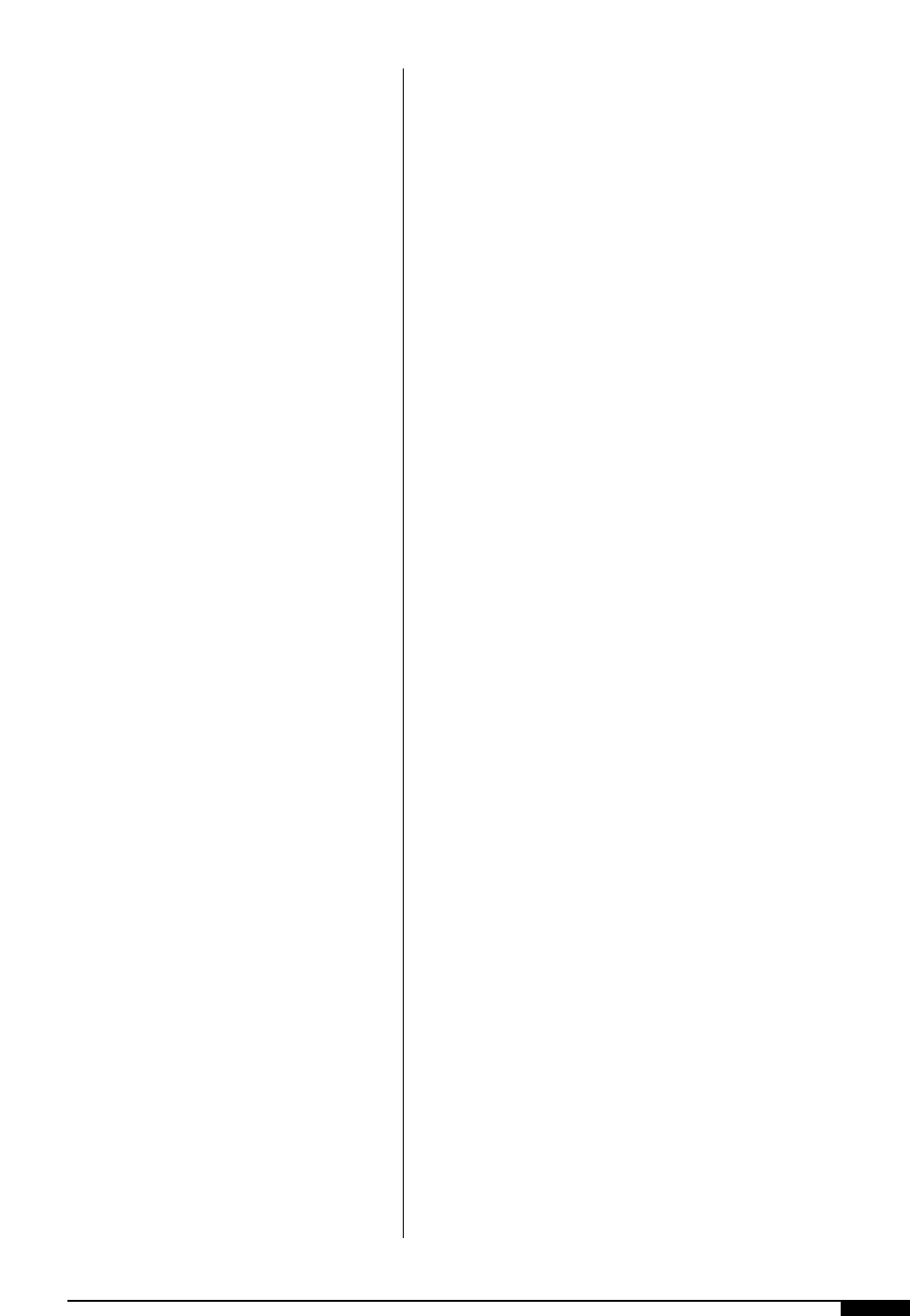
gle pass on narrow-web presses. Other
examples of similar applications are paper
cups and sidewalls for dairy product con-
tainers.
Business Forms and Form/Label Combinations.
To produce form/label combinations, a dual
unwind is required together with some form
of adhesive applicator.
Lids and Closures. Foil lids for juices and
yogurt cups, for example, can be converted
on narrow-web equipment. Likewise, paper-
board lids, such as for ice cream containers,
can be produced in a single pass on narrow-
web presses. These lids often include a lam-
inated viewing window that requires blank-
ing out the window, applying a patterned
adhesive, laminating and then diecutting the
laminate. As with folding cartons, the foil
and paperboard lids are blanked out and
delivered on a conveyor or stacker.
Tickets. A variety of tickets can be converted
on narrow-web equipment. Depending on the
use of the ticket, these may require high-
quality graphics, as for sport and entertain-
ment venues, or precision-cut lengths for
automatic dispensing of turnpike tickets.
Lottery tickets require multiple print and
coating stations and the use of special inks.
Increasingly, security and anti-counterfeit
features are incorporated into tickets for
authentication and tracking.
Tags. The retail industry uses a tremendous
number of tags in a variety of forms, includ-
ing hang tags, static-cling tags and pressure-
sensitive tags. All of these can be produced
on narrow-web presses.
Flexible Packaging. Wraps for beverage con-
tainers and other products are printed roll to
roll on narrow web presses, as is packaging
for food products. Tubes, such as those used
for toothpaste and gel containers, are also
produced on narrow web equipment.
Coupons and Information Booklets. Instant
redeemable coupons and extended informa-
tion booklets are increasingly popular pro-
motional and information vehicles. They
require multiple unwinds, the ability to print
and die-cut the webs individually, and the
application of adhesives. All of this is done in
a single pass on narrow-web presses.
Pressure-Sensitive Labels. The most common
use of narrow-web presses is to produce
pressure-sensitive labels. These products
are used for product promotion and identifi-
cation (prime labels), ingredient and usage
instructions (secondary labels), material
tracking and control, and promotional
pieces, to name just a few examples.
Self-wound, Self-adhesive Tapes. Tapes are
used for promotion and identification of a
number of products, including tires, metal
rods and conductive wires.
Other. Other uses growing in popularity
include medical and pharmaceutical packag-
ing, in-mold labels, and shelf markers and
shelf talkers.
THE NARROW WEB PROCESS
Since most narrow-web presses are in-line
presses, we will use that design, generally, for
the purposes of describing the components
of narrow-web equipment. The description
will also be, for the most part, of a generic
press for pressure-sensitive labels. The pri-
mary elements of these presses are:
• unwind;
• in-feed and tension control;
• print stations;
• drying and curing;
• die-cut stations;
• waste removal; and
• delivery.
Unwind
The unwind of a modern narrow-web press
can, generally, handle rolls up to 1,000 lbs. or
40" (101 cm) in diameter. A roll loader will
often be built into the press to assist in han-
dling large rolls. A splicing platform and web
guide are also usually included in the unwind
module. The web guide may be a manual
PRESSES AND PRESS EQUIPMENT 19

20 FLEXOGRAPHY: PRINCIPLES & PRACTICES
device, but more typically is automatic.
Automatic web guides may be hydraulic or
pneumatic and may use an optic, sonic or
pneumatic sensor.
Unwind Tension. An unwind brake is used to
apply tension to the web as it is unwound
from the roll. The braking device, which may
be pneumatic, magnetic or electric, is me-
chanically coupled to the unwind core-hold-
er to restrict its rotation. The brake may
apply either a constant, fixed force, or it may
vary the force to obtain a constant tension.
Constant-torque systems, which apply a
fixed force, are efficient only with smaller
diameter rolls, such as those less than 15"
(38 cm) in diameter. Since the braking force
is generally applied at the core-holder, the
force required to obtain a given tension is
greater at larger diameters than at smaller
diameters. Consequently, if large diameter
rolls are used with constant-torque brakes,
the press operator must periodically adjust
the brake as the roll diameter changes.
Constant-torque systems are usually used
only on small central impression presses
with limited roll sizes, and in situations
where the printing and converting accuracy
is not critical.
Constant-tension systems continually
adjust the torque of the brake as the roll
diameter changes. This can be done either
by sensing the diameter of the roll or by
measuring tension changes. Sonic and opti-
cal sensors are the most common methods
used on narrow-web presses to monitor roll
diameter. In some cases, a follower roller
maintains physical contact with the roll of
material. Tension-responsive systems are
also commonly used on narrow-web press-
es. These systems may employ a load cell to
measure absolute web tension, or a dancer
system that uses a counterbalance measure
of tension. The typical narrow-web dancer
system will be pneumatically loaded against
the tension created by the unwind brake. An
advantage of the dancer system is that it will
accumulate and release material if neces-
sary, such as with irregularly wound rolls or
during speed changes.
Unwind stands capable of handling rolls
greater than 40" (101 cm) in diameter can be
used with narrow web presses. These stands
are often supplied with presses purchased for
folding carton applications. In some
instances, these larger roll stands will incor-
porate multiple unwind stands with automat-
ic splicing to provide continuous, nonstop
production. Automatic splice stands are also
used for high-volume label production. These
stands must make butt-splices to avoid dam-
age to dies, while allowing continuous wind-
ing of the die-cut waste matrix. Multiple
unwind modules without automatic splicing
are also commonly used on narrow-web
presses for applications that require lamina-
tion of multiple webs, including coupons and
form/label combinations.
In-feed and Tension Control
Some narrow-web presses use only the
tension created by the unwind brake to con-
trol the web as it enters the process area.
However, most have some form of in-feed
pacing in addition to an unwind tension sys-
tem. The in-feed pacing system will have a
driven roller and a rubber nip roller. In some
cases, the system will also have a tension
monitoring device and regulating controls.
Those systems without a monitoring and
control loop are called “open loop” systems.
The driven roller in these systems will have
a fixed velocity relative to press speed.
“Closed loop” systems, those with a moni-
toring and control system, allow a press
operator to select a web-tension level that is
to be maintained. This is done with an elec-
tronic feedback system, which monitors the
tension of the web and compares it to the
selected tension level. Depending on the sys-
tem, a constant tension is maintained by
varying the velocity of the driven roller or of
the braking torque applied to it.
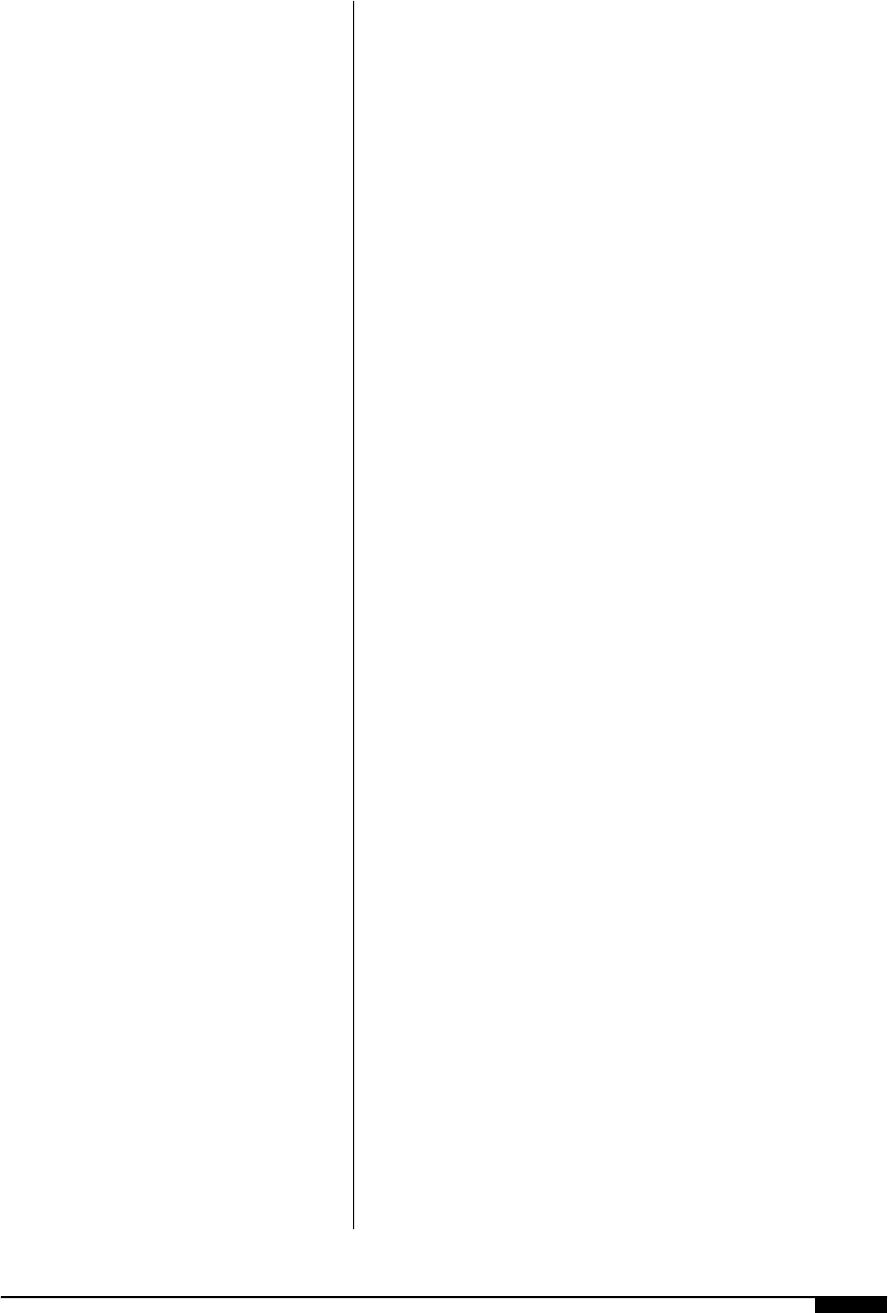
Some narrow-web presses can vary the
velocity of both the in-feed and the exit pac-
ing rollers. This capability allows the press
operator to alter tension while maintaining a
constant amount of material passing through
the press on each revolution. Some applica-
tions, such as EDP labels, require an exact,
specified throw length, or spacing of the
labels and feed holes. The capability to alter
tension without affecting throw length is very
important to converters of these products.
In-feed pacing systems are used to create
an initial web tension and to control the web
as it enters the press. Maintaining tension
through the press is the function of the exit-
pacing roller, and, to a lesser extent, all of
the driven rollers in the press. Web control is
obtained on all web presses through tension.
H o w e v e r, as the web passes through the
press and over rollers, it loses energy due to
friction, inertia and deformation. These
energy losses reduce web tension. To bal-
ance the energy losses and maintain ade-
quate tension through the press, the exit-
pacing roller will, typically, have a higher
velocity than the other rollers in the press.
Some press designs will have a slight, but
precise, gradation of the velocity of all dri-
ven rollers. The gradient can be introduced
by minute changes to the diameter of the
rollers to alter their surface speed, or by use
of servo motors to regulate roller velocity.
Print Stations
As with any flexo press, narrow-web press-
es use an anilox roll to control the amount of
ink applied to the printing plate. Many nar-
row-web presses are supplied with laser-
engraved ceramic anilox rolls, although
mechanically engraved chrome rolls are also
used. Metering of the ink film is typically
done with a reverse-angle doctor blade in a
two-roll system. In these systems, the foun-
tain roller is used to flood the anilox roll with
ink. The rubber fountain, or doctor, roller
may be driven at a one-to-one ratio to the
press speed, or at a slower ratio. If desired,
the fountain roller, instead of the doctor
blade, may be used to meter the ink. Some
narrow-web presses are designed to use only
a doctor blade and do not have a metering
r o l l e r. Either conventional reverse-angle doc-
tor blades or chambered doctor blade sys-
tems are used in these cases.
Repeat Lengths. Narrow-web presses do not
have a fixed print repeat. A typical narrow
web press will have a repeat range of approx-
imately 5" to 24" (127 mm-610 mm). Also, nar-
row-web presses print on a wide range of
materials with varying thickness. As a conse-
quence, narrow-web presses must allow pre-
cise adjustment of plate cylinders with a
wide range of diameters, to materials of vary-
ing caliper. This is typically done with
“adjusting arms” that move perpendicular to
the point at which the plate cylinder contacts
the anilox and impression rollers. The plate
cylinder is captured in the adjusting arms
with journals or by a rod passing through the
plate cylinder bearings. The movement of the
adjusting arms must be sufficient to accom-
modate the full repeat length range. In addi-
tion to this coarse positioning of the plate
c y l i n d e r, finite adjustments are provided to
establish precise pressure settings between
the printing plate and the anilox roll, and
between the plate and the web. This can be
done either by adjustment of the position of
the plate cylinder relative to ink and web, or
by positioning the plate cylinder to the web
and adjusting the anilox roll position to the
plate. Regardless of the method used, the
mechanism must be rigid to avoid plate-roll
bounce and to maintain the pressure settings
throughout the run. Figure
i
shows a typi-
cal narrow-web print station.
Registration Adjustment. Because the repeat
length is variable on narrow-web presses,
there is not a constant relationship that
establishes close linear register position
between stations. Consequently, narrow-web
presses provide for both coarse and fine reg-
PRESSES AND PRESS EQUIPMENT 21
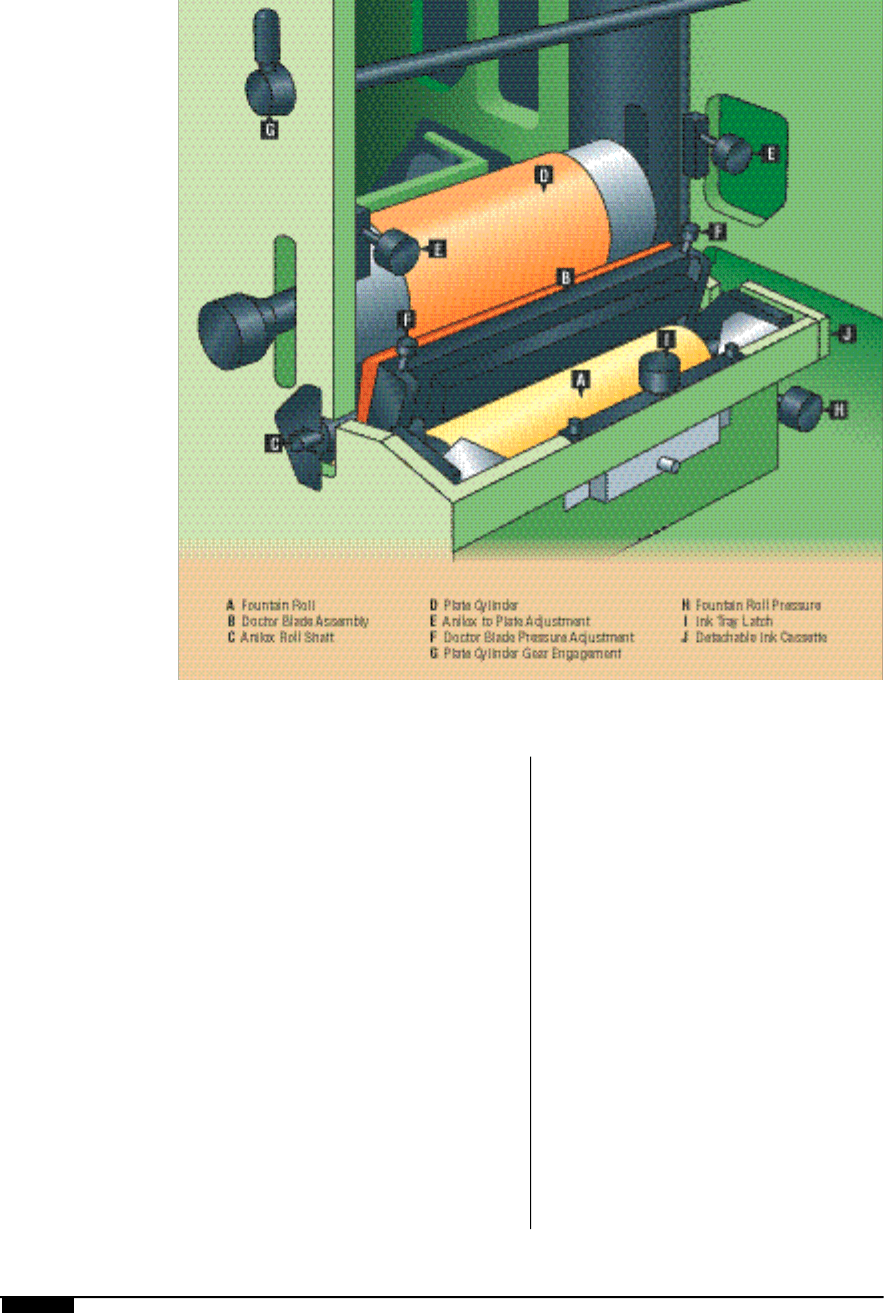
22 FLEXOGRAPHY: PRINCIPLES & PRACTICES
ister adjustments. Coarse register adjust-
ments are made in a number of ways on nar-
row-web presses. The most common is by
disengaging the gear of the plate cylinder
from its drive gear and rotating the plate
c y l i n d e r. Another method is to use a high-
speed motor to rotate the plate cylinder. This
method is sometimes used for automatic pre-
register systems. With preregister systems,
the operator positions all of the plate rolls at
the equivalent of top-dead-center, and enters
the repeat length information into a proces-
s o r. The processor calculates the amount
each plate cylinder needs to be rotated, or
offset, to obtain a coarse register position.
Coarse positioning is used to register the
print to within approximately one gear
tooth, typically 0.125". Fine positioning, to
establish precise register, may be a manual
or an automatic function. Fine adjustments
are usualy made through a worm gear to
momentarily change the velocity of the plate
cylinder or die. This adjustment results in a
phase shift of the position of the tooling. The
adjustment range may be a full 360°, or with-
in a prescribed window.
Automatic Register Systems. Automatic regis-
ter systems normally are used with 360° gear-
boxes, but they can also be used with sys-
tems with a restricted adjustment range. Tw o
basic types of automatic register systems are
used on narrow-web presses. One style is a
mark-to-mark system. This style uses one or
more optic sensors to “read” the position of a
series of sequentially printed register marks.
The other style of automatic register system
i
A typical narrow-web
print station layout.
i
